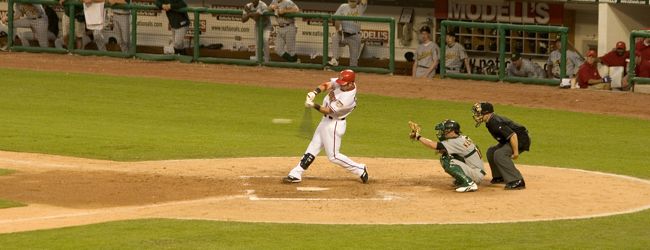
I’ve been getting many questions lately about our baseball training from high school coaches. The number one question is “How do we implement rotational work into the training?” Most small schools and high schools don’t have access to cables or bands, or they have so many kids that, due to time constraints, this wouldn’t be feasible anyway.
I’ve uploaded three videos of our plate rotation series that can be implemented with large groups of athletes. They’re also great for teaching rotational movement patterns to beginners. I utilize these often with our younger athletes at TCU, especially in our freshmen preparation program. These are great for teaching hip rotation and t-spine rotation while locking in the lumbar spine. Being able to do that is the foundation to virtually all rotational movements, especially swings (as in a golf swing, baseball swing, etc.).
The foundation of all these movements is a square lower half at the bottom of each exercise. We don’t want the knees to collapse. At the bottom, emphasize rotating the shoulders while keeping the hips and knees square. As we rotate up, we don’t want the spine to do all the rotation (i.e. keeping the feet in place). We want to emphasize blocking the front hip and rotating/following through with the back hip. I cue the athletes to rotate around the front hip. These are great exercises to get the rotators of the hip firing as well as to increase hip internal rotation without actually stretching or even having athletes know about it.
With plate rotations, we want to keep the arms straight and rotate up diagonally. The biggest problem I see here is that athletes load up with too much weight and then they aren’t able to hold it. We don't want much weight here. The other movements can be loaded more significantly, but for this one, I want the pattern done correctly regardless of weight.
The second movement in this series is the plate stamp. With plate stamps, the foundation of the movement stays the same. The hips stay square with the shoulders rotated at the bottom. The difference is we break the arms and pull the plate into the chest. Then we drive it up diagonally as we rotate. This is second in our series because we have trained the rotational pattern with light weight. Now we can increase the weight and begin utilizing our hip and leg drive. We really want our athletes to drive the plate up with the back side hip and leg.
The last movement in the series is alternating plate rotations. These can actually be loaded the most and can help teach explosive hip rotation. I compare this movement to a kettlebell swing of sorts. The difference is in the starting position. The athlete holds the plate between his legs in a squat instead of rotated at the bottom. As we come up, all rotation stays the same. We still block the front side leg and rotate around it by following through with the backside. The arms stay straight in this exercise, and we utilize the hips and legs to forcefully drive the weight up. Athletes shouldn't get tired in the arms or shoulders here. If they do, they're performing the movement incorrectly. Remember, according to Chubbs, “It’s all in the hips!” That’s Happy Gilmore for those of you wondering.
From here, we will progress to our more advanced rotational exercises that begin incorporating transverse plane loading. In addition, we move into our rotational speed/power movements.
In all of these movements, we aren’t trying to duplicate swings or any type of sport activity. We are teaching and training rotational /diagonal movement patterns that involve hip and thoracic spine rotation. Too often, athletes think we’re trying to reproduce some type of swing in the weight room. This isn’t the objective and it isn’t good for anyone’s swing mechanics. Use the weight room for teaching and training general movements and patterns and the field for teaching and training sport specificity.









